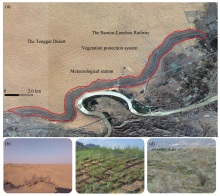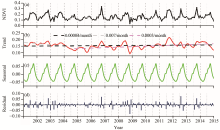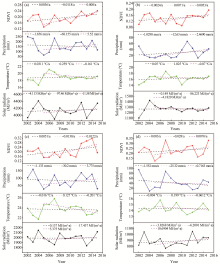Sciences in Cold and Arid Regions ›› 2021, Vol. 13 ›› Issue (1): 43–52.doi: 10.3724/SP.J.1226.2021.20030
Response of revegetation to climate change with meso- and micro-scale remote sensing in an arid desert of China
Guang Song1,2,BingYao Wang1,JingYao Sun1,3,YanLi Wang1,3,XinRong Li1,2( )
)
- 1.Shapotou Desert Research and Experimental Station, Northwest Institute of Eco-Environment and Resources, Chinese Academy of Science, Lanzhou, Gansu 730000, China
2.Key Laboratory of Stress Physiology and Ecology in Cold and Arid Regions of Gansu Province, Northwest Institute of Eco-Environment and Resources, Chinese Academy of Sciences, Lanzhou, Gansu 730000, China
3.University of Chinese Academy of Sciences, Beijing 100049, China
|
Barriopedro D, Gouveia CM, Trigo RM, et al., 2012. The 2009/10 Drought in China: Possible Causes and Impacts on Vegetation. Journal of Hydrometeorology, 13(4): 1251-1267. DOI: 10.1175/JHM-D-11-074.1.
doi: 10.1175/JHM-D-11-074.1 |
|
|
Boschetti M, Nutini F, Brivio PA, et al., 2013. Identification of environmental anomaly hot spots in West Africa from time series of NDVI and rainfall. ISPRS Journal of Photogrammetry and Remote Sensing, 78: 26-40. DOI: 10.1016/j.isprsjprs.2013.01.003.
doi: 10.1016/j.isprsjprs.2013.01.003 |
|
|
Buermann W, Parida B, Jung M, et al., 2014. Recent shift in Eurasian boreal forest greening response may be associated with warmer and drier summers. Geophysical Research Letters, 41(6): 1995-2002. DOI: 10.1002/2014GL059450.
doi: 10.1002/2014GL059450 |
|
|
Chen N, Ratajczak Z, Yu K, 2019. A dryland re-vegetation in northern China: Success or failure? Quick transitions or long lags? Ecosphere, 10(4): e02678. DOI: 10.1002/ecs2. 2678.
doi: 10.1002/ecs2. 2678 |
|
|
De Jong R, Verbesselt J, Schaepman ME, et al., 2012. Trend changes in global greening and browning: contribution of short-term trends to longer-term change. Global Change Biology, 18(2): 642-655. DOI: 10.1111/j.1365-2486.2011. 02578.x.
doi: 10.1111/j.1365-2486.2011. 02578.x |
|
|
Evans SE, Byrne KM, Lauenroth WK, et al., 2011. Defining the limit to resistance in a drought-tolerant grassland: long-term severe drought significantly reduces the dominant species and increases ruderals. Journal of Ecology, 99(6): 1500-1507. DOI: 10.1111/j.1365-2745.2011.01864.x.
doi: 10.1111/j.1365-2745.2011.01864.x |
|
|
Fensholt R, Langanke T, Rasmussen K, et al., 2012. Greenness in semi-arid areas across the globe 1981-2007 — an Earth Observing Satellite based analysis of trends and drivers. Remote Sensing of Environment, 121: 144-158. DOI: 10. 1016/j.rse.2012.01.017.
doi: 10. 1016/j.rse.2012.01.017 |
|
|
Fensholt R, Proud SR, 2012. Evaluation of earth observation based global long term vegetation trends—Comparing GIMMS and MODIS global NDVI time series. Remote sensing of Environment, 119: 131-147. DOI: 10.1016/j.rse. 2011.12.015.
doi: 10.1016/j.rse. 2011.12.015 |
|
|
Gessner U, Naeimi V, Klein I, et al., 2013. The relationship between precipitation anomalies and satellite-derived vegetation activity in Central Asia. Global and Planetary Change, 110: 74-87. DOI: 10.1016/j.gloplacha.2012.09.007.
doi: 10.1016/j.gloplacha.2012.09.007 |
|
|
Holmgren M, Stapp P, Dickman CR, et al., 2006. Extreme climatic events shape arid and semiarid ecosystems. Frontiers in Ecology and the Environment, 4(2): 87-95. DOI: 10. 1890/1540-9295(2006)004[0087:ECESAA]2.0.CO;2.
doi: 10. 1890/1540-9295(2006)004 |
|
|
Huang L, He B, Chen A, et al., 2016. Drought dominates the interannual variability in global terrestrial net primary production by controlling semi-arid ecosystems. Scientific Reports, 6: 24639. DOI: 10.1038/srep35126.
doi: 10.1038/srep35126 |
|
|
Hughes TP, Linares C, Dakos V, et al., 2013. Living dangerously on borrowed time during slow, unrecognized regime shifts. Trends in Ecology and Evolution, 28(3): 149-155. DOI: 10.1016/j.tree.2012.08.022.
doi: 10.1016/j.tree.2012.08.022 |
|
|
Killick R, Fearnhead P, Eckley IA, 2012. Optimal detection of changepoints with a linear computational cost. Journal of the American Statistical Association, 107(500): 1590-1598. DOI: 10.1080/01621459.2012.737745.
doi: 10.1080/01621459.2012.737745 |
|
|
Kim JY, Rastogi G, Do Y, et al., 2015. Trends in a satellite-derived vegetation index and environmental variables in a restored brackish lagoon. Global Ecology and Conservation, 4: 614-624. DOI: 10.1016/j.gecco.2015.10.010.
doi: 10.1016/j.gecco.2015.10.010 |
|
|
Krishnan P, Black TA, Grant NJ, et al., 2006. Impact of changing soil moisture distribution on net ecosystem productivity of a boreal aspen forest during and following drought. Agricultural and Forest Meteorology, 139(3-4): 208-223. DOI: 10.1016/j.agrformet.2006.07.002.
doi: 10.1016/j.agrformet.2006.07.002 |
|
|
Li XR, Jia XH, Long LQ, et al., 2005. Effects of biological soil crusts on seed bank, germination and establishment of two annual plant species in the Tengger Desert (N China). Plant and Soil, 277(1-2): 375-385. DOI: 10.1007/s11104-005-8162-4.
doi: 10.1007/s11104-005-8162-4 |
|
|
Li X, Gao Y, Su J, et al., 2014. Ants mediate soil water in arid desert ecosystems: Mitigating rainfall interception induced by biological soil crusts? Applied Soil Ecology, 78: 57-64. DOI: 10.1016/j.apsoil.2014.02.009.
doi: 10.1016/j.apsoil.2014.02.009 |
|
|
Li X, Tian F, Jia R, et al., 2010. Do biological soil crusts determine vegetation changes in sandy deserts? Implications for managing artificial vegetation. Hydrological Processes, 24(25): 3621-3630. DOI: 10.1002/hyp.7791.
doi: 10.1002/hyp.7791 |
|
|
Li X, Zhang Z, Huang L, et al., 2013. Review of the ecohydrological processes and feedback mechanisms controlling sand-binding vegetation systems in sandy desert regions of China. Chinese Science Bulletin, 58(13): 1483-1496. DOI: 10.1007/s11434-012-5662-5.
doi: 10.1007/s11434-012-5662-5 |
|
|
Lloret F, Siscart D, Dalmases C, 2004. Canopy recovery after drought dieback in holm-oak Mediterranean forests of Catalonia (NE Spain). Global Change Biology, 10(12): 2092-2099. DOI: 10.1111/j.1365-2486.2004.00870.x.
doi: 10.1111/j.1365-2486.2004.00870.x |
|
|
Mohammat A, Wang X, Xu X, et al., 2013. Drought and spring cooling induced recent decrease in vegetation growth in Inner Asia. Agricultural and Forest Meteorology, 178: 21-30. DOI: 10.1016/j.agrformet.2012.09.014.
doi: 10.1016/j.agrformet.2012.09.014 |
|
|
Piao S, Ciais P, Huang Y, et al., 2010. The impacts of climate change on water resources and agriculture in China. Nature, 467(7311): 43. DOI: 10.1038/nature09364.
doi: 10.1038/nature09364 |
|
|
Piao S, Cui M, Chen A, et al., 2011. Altitude and temperature dependence of change in the spring vegetation green-up date from 1982 to 2006 in the Qinghai-Xizang Plateau. Agricultural and Forest Meteorology, 151(12): 1599-1608. DOI: 10.1016/j.agrformet.2011.06.016.
doi: 10.1016/j.agrformet.2011.06.016 |
|
|
Poulter B, Frank D, Ciais P, et al., 2014. Contribution of semi-arid ecosystems to interannual variability of the global carbon cycle. Nature, 509(7502): 600. DOI: 10.1038/nature13376.
doi: 10.1038/nature13376 |
|
|
Qu L, Chen J, Dong G, et al., 2016. Heat waves reduce ecosystem carbon sink strength in a Eurasian meadow steppe. Environmental Research, 144: 39-48. DOI: 10.1016/j.envres. 2015.09.004.
doi: 10.1016/j.envres. 2015.09.004 |
|
|
Song G, Li X, Hui R, 2017. Effect of biological soil crusts on seed germination and growth of an exotic and two native plant species in an arid ecosystem. PloS One, 12(10): e0185839. DOI: 10.1371/journal.pone.0185839.
doi: 10.1371/journal.pone.0185839 |
|
|
Thiet RK, Doshas A, Smith SM, 2014. Effects of biocrusts and lichen-moss mats on plant productivity in a US sand dune ecosystem. Plant and Soil, 377(1-2): 235-244. DOI: 10. 1007/s11104-013-2002-8.
doi: 10. 1007/s11104-013-2002-8 |
|
|
Tian H, Cao C, Chen W, et al., 2015. Response of vegetation activity dynamic to climatic change and ecological restoration programs in Inner Mongolia from 2000 to 2012. Ecological Engineering, 82: 276-289. DOI: 10.1016/j.ecoleng. 2015.04.098.
doi: 10.1016/j.ecoleng. 2015.04.098 |
|
| Wang T, 2003. Desert and Desertification in China. Shijiazhuang: Hebei Science and Technology Publishing House, 641-648. | |
|
Wen Z, Wu S, Chen J, et al., 2017. NDVI indicated long-term interannual changes in vegetation activities and their responses to climatic and anthropogenic factors in the Three Gorges Reservoir Region, China. Science of Total Environment, 574: 947-959. DOI: 10.1016/j.scitotenv.2016.09.049.
doi: 10.1016/j.scitotenv.2016.09.049 |
|
|
Xia Q, Qin CZ, Li H, et al., 2018. Mapping mangrove forests based on multi-tidal high-resolution satellite imagery. Remote Sensing, 10: 1343. DOI: 10.3390/rs10091343.
doi: 10.3390/rs10091343 |
|
|
Xu HJ, Wang XP, Yang TB, 2017. Trend shifts in satellite-derived vegetation growth in Central Eurasia, 1982-2013. Science of Total Environment, 579: 1658-1674. DOI: 10. 1016/j.scitotenv.2016.11.182.
doi: 10. 1016/j.scitotenv.2016.11.182 |
|
|
Xu HJ, Wang XP, Zhang XX, 2016. Decreased vegetation growth in response to summer drought in Central Asia from 2000 to 2012. International Journal of Applied Earth Observation and Geoinformation, 52: 390-402. DOI: 10. 1016/j.jag.2016.07.010.
doi: 10. 1016/j.jag.2016.07.010 |
|
| Yaffee RA, McGee M, 2000. An introduction to time series analysis and forecasting: with applications of SAS® and SPSS®: Elsevier. | |
|
Zhang DH, Li XR, Zhang F, et al., 2016. Effects of rainfall intensity and intermittency on woody vegetation cover and deep soil moisture in dryland ecosystems. Journal of Hydrology, 543: 270-282. DOI: 10.1016/j.jhydrol.2016. 10.003.
doi: 10.1016/j.jhydrol.2016. 10.003 |
|
| Zhang J, Zhang L, Xu C, et al., 2014. Vegetation variation of mid-subtropical forest based on MODIS NDVI data—A case study of Jinggangshan City, Jiangxi Province. Acta Ecologica Sinica, 34(1): 7-12. | |
|
Zhang ZS, Zhao Y, Li XR, et al., 2016. Gross rainfall amount and maximum rainfall intensity in 60-minute influence on interception loss of shrubs: a 10-year observation in the Tengger Desert. Scientific Reports, 6: 26030. DOI: 10.1038/srep26030.
doi: 10.1038/srep26030 |
| No related articles found! |








